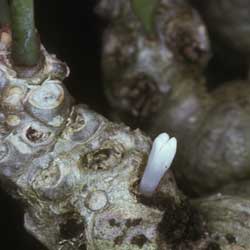Myrmecodia beccarii
 |
 |
an Ant Plant
Myrmecodia beccarii is an ant plant that is endemic to Australia. It only occurs in the mangroves and lowland forests found around Cairns and northern Cape York.
 M.
beccarii is distinguishable from other ant plants through its small and
succulent leaves, as well as through its tendency to develop multiple stems.
Typical for most ant plants are the hypocotyls, which are stems that enlarge
to form a tuber-like structure. In Myrmecodia beccarii, these hypocotyls
are covered in ridges and spines. The white flowers are not very conspicuous,
as they are formed in hollows along the alveoli (stem). The ripe fruit then
protrudes from the alveoli and they can be white, red, orange or pink.
M.
beccarii is distinguishable from other ant plants through its small and
succulent leaves, as well as through its tendency to develop multiple stems.
Typical for most ant plants are the hypocotyls, which are stems that enlarge
to form a tuber-like structure. In Myrmecodia beccarii, these hypocotyls
are covered in ridges and spines. The white flowers are not very conspicuous,
as they are formed in hollows along the alveoli (stem). The ripe fruit then
protrudes from the alveoli and they can be white, red, orange or pink.
When the plant grows, tissue within the tuber dies back and hollow chambers form. These chambers allow ants (mostly Iridomyrmex cordatus) to enter the plant. A symbiotic relationship exists between the plant and the ants; the plant provides a protective shelter for the ants, in turn the ants provide additional nutrients to the plant with its food leftovers. Not all plants are inhabited but examinations have proven that in the wild, the vast majority of plants house ant colonies.
It is very easy to propagate Myrmecodia beccarii from seed. Seeds germinate readily along the stems of trees in glasshouse conditions. The main thing to consider when propagating from seed is to keep the substrate moist. The use of free draining terracotta or open mesh pots (used for orchids) is ideal. The plants should dry out between waterings, however not too much otherwise they will wilt. Plants in pots should be watered about every second or third day. Plants that are mounted on slabs (the ANBG uses cork) need daily watering. In cooler weather, watering must be reduced, otherwise brown and corky patches will appear on the leaves.
Currently the ANBG uses a coarse epiphytic potting mix consisting of:
- 3 parts weathered (new resins will poison the plants) red gum chips (25-30mm)
- 1 part sand
- 1/2 part coco-peat
- 5 parts sieved and washed scoria
In the future, though, the ANBG will change to ‘boiled bark’. This is pre-weathered bark and lasts longer because the soft parts have been boiled out.
To grow Myrmecodia beccarii, high temperatures are needed to match its natural habitat conditions. It thrives within a night/day range of low 20°s to low 30°s. In summer, liquid fertiliser should be added once a week. The ANBG uses a half-strength liquid orchid fertiliser (100 parts/million of nitrogen). In autumn and spring, the plants should be liquid fertilised once a fortnight and in winter about once a month. Slow release fertiliser can be used as an alternative in spring if preferred, but apply sparingly as ant plants are slow growing.
No pests or diseases have been observed to date, though they could potentially suffer from pest insects such as scale, mealy bugs, mites or aphids.
Text by Cornelia Garbe (2004 Student Botanical Intern)
Derivation of the name: Myrmecodia beccariiMyrmecodia – from the Greek ‘myrmekodes’, meaning ant-like or full of ants beccarii - after the botanist Oleardo Beccari |
References
Buckley, R.C. (ed.) (1982) Ant-plant interactions in Australia. Dr W. Junk Publishers, The Hague.
WTMA (Wet Tropics Management Authority) (2004) Insects in the wet tropics: Green ants. Available at:
http://www.wettropics.gov.au/pa/pa_ants.html [Accessed on 2004, 30 April]Nick’s Plant Pages (2001) Ant plants. Available at:
http://www.duke.edu/~nplummer/beccarii.html. [Accessed on 2004, 7 February]Lamp, C.A., Forbes, S.J. & Cade, J.W. (ed. Pressley, M.) (1990) Grasses of Temperate Australia. Inkata Press, Melbourne.
See a 3D internal view of Myrmecodia beccarii courtesy of Dr Tim Senden, Dept. Applied Mathematics, Research School of Physical Sciences and Engineering, Australian National University.
X-ray photo Myrmecodia beccarii
![An Australian Government Initiative [logo]](/images/austgovt_brown_90px.gif)


